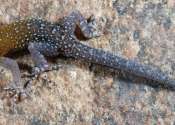Discovering van Gogh in the wild: Scientists unveil a new gecko species
You've probably seen nature depicted in art, but how often do you see an artwork hiding in nature?

You've probably seen nature depicted in art, but how often do you see an artwork hiding in nature?
Plants & Animals
Mar 28, 2024
0
212

Lyme disease is a stealthy, often misdiagnosed disease that was only recognized about 40 years ago, but new discoveries of ticks fossilized in amber show that the bacteria which cause it may have been lurking around for 15 ...
Archaeology
May 29, 2014
0
0

Like humans, mice can become infected with Borrelia. However, not all mice that come into contact with these bacteria contract the dreaded Lyme disease: Animals with a particular gene variant are immune to the bacteria, as ...
Plants & Animals
Apr 4, 2013
0
1

A species of exotic tick arrived in Ohio in 2021 in such huge numbers that their feeding frenzy on a southeastern farm left three cattle dead of what researchers believe was severe blood loss.
Ecology
Nov 3, 2023
0
165

Cedarwood oil can be found in many consumer products—perfumes, soaps and deodorants among them. In addition to its pleasing scent, cedarwood oil also is prized for its insect-repelling and anti-fungal properties.
Plants & Animals
Feb 16, 2022
0
100

The Longhorned tick causes the loss of millions of dollars in agricultural revenue to cattle producers worldwide, and it is now in northern Missouri.
Ecology
Sep 24, 2022
0
47

A study led by researchers at Washington State University has pinpointed a protein that appears to play a pivotal role in how a harmful bacteria that causes the disease anaplasmosis establishes itself in ticks before being ...
Cell & Microbiology
Sep 29, 2023
0
106
As part of her research into breast cancer, University of Rhode Island scientist Roberta King has for years been studying the role of an enzyme in regulating estrogen activity.
Biochemistry
Feb 2, 2011
0
0

Researchers have successfully used CRISPR-Cas9 to edit the genomes of the black-legged tick. To accomplish this feat, they developed an embryo injection protocol that overcame a major barrier in the field. The work appears ...
Biotechnology
Feb 15, 2022
1
147

Seconds after Mike Braun spotted the deer in his headlights his six-day-old car had $8,000 worth of damage, including a punctured radiator.
Ecology
Aug 30, 2013
6
0